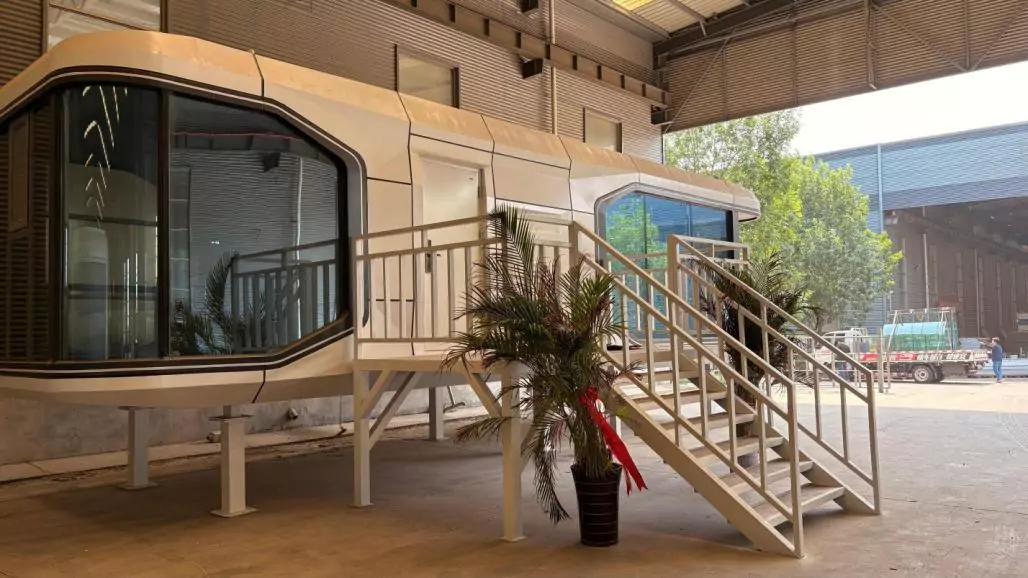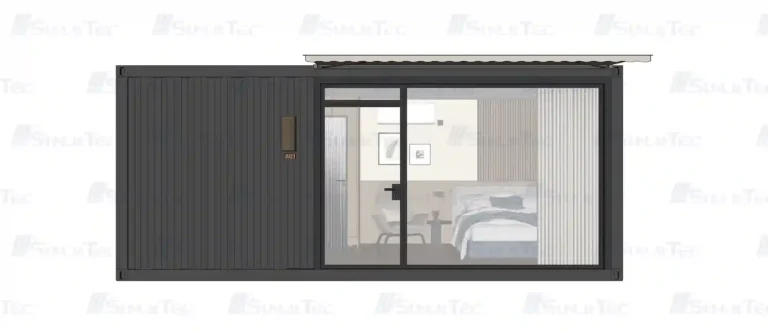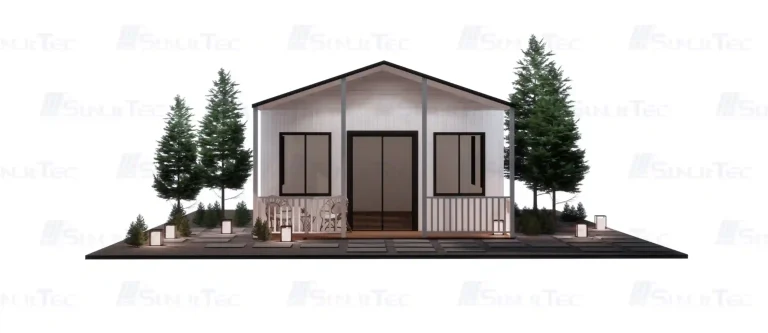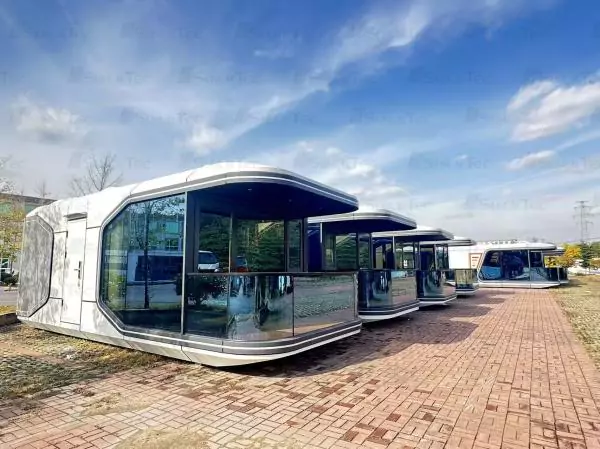يتم شحن الإسكان الكبسولة التقليدية ككل ، والنقل والرفع مزعج للغاية. أثناء النقل ، بسبب حجمها الكبير ، يجب استخدام مركبات النقل الكبيرة ، كما تخضع لقيود على ارتفاع الطرق وعرضها ، مما يعرض للمشاكل. مطلوبة رافعات كبيرة أو رافعات للتركيب أثناء التحميل والتركيب الأرضي. ولا يمكن نقل تصميمها العالي للغاية والعميل للغاية في حاويات الشحن ، لذلك يزيد هذا بشكل كبير من تكلفة الشحن.

سكن كبسولة وحدات تقسم المنزل إلى وحدات قياسية متعددة. خذ منزل كبسولة مساحته 15 متر مربع كمثال. الشحنة الكلية تشغل مساحة 45 متر مكعب؛ بعد التوحيد ، يشغل التخزين المكدس حوالي 20 متر مكعب فقط ، مما يوفر أكثر من 50٪ من المساحة ، بحيث يمكن نقله في حاوية شحن ، ويمكن لحاوية شحن واحدة أن تحمل مجموعات 2-3 ، مما يوفر تكاليف النقل بشكل كبير.
من ناحية النقل ، فإن التوحيد لديه مزايا واضحة. هناك حاجة إلى معدات خاصة للنقل العام ، وهو مكلف ومخاطر ، وأكثر إزعاجاً عندما تكون ظروف الطرق سيئة. يمكن نقل الوحدات المكونة من وحدات بواسطة شاحنات عادية للشاحنات الصغيرة ويمكن نقلها بعد تفكيكها للشاحنات الكبيرة ، مما يقلل من متطلبات ومخاطر معدات النقل. تظهر البيانات أن النقل المتكامل يمكن أن يقلل من تكاليف الشحن بنسبة 30 ٪ – 40%.
بالإضافة إلى مزايا الفضاء والشحن ، تضمن مواد منازل كبسولة الفضاء الموحدة أيضًا جودة المنازل. القشرة الخارجية مصنوعة من لوحة الألومنيوم الطيران، والتي ليست فقط خفيفة الوزن، ولكن أيضا قوية ومقاومة للتآكل. يمكن أن تتحمل الطقس السيئ وليس من السهل تشوه أو تتلاشى بعد الاستخدام على المدى الطويل. طبقة العزل تستخدم البولي يوريثان 50-150mm. البولي يوريثان لديه القدرة على الحفاظ على الحرارة بكفاءة وهو حاليا مادة عالية الجودة نسبيا في طبقة العزل للمنازل المكونة من وحدات. يمكن أن يمنع نقل الحرارة بشكل فعال ، ويعزل في الصيف ويقاوم البرد في الشتاء ، بحيث يمكن للمنزل الحفاظ على درجة حرارة مريحة وتقليل استهلاك الطاقة للمعدات مثل مكيفات الهواء.
المواد الداخلية من منزل كبسولة الفضاء التركيز على العملية والسلامة. الجدار مصنوع من لوحة كريستال الكربون. لا تحتوي هذه اللوحة فقط على مواد ضارة مثل الفورمالدهيد ، وهي صديقة للبيئة وآمنة ، ولكن لديها أيضًا مقاومة للحريق والرطوبة ، ولها عزل صوتي جيد. يمكن أن يعزل بفعالية الضوضاء الخارجية وخلق بيئة هادئة ومريحة للسكان. السطح العلوي هو سقف متكامل من الألومنيوم ، وهو خفيف في المواد ولا يتطلب عمليات معقدة مثل اللحام أثناء التثبيت. يمكن تجميعها بسرعة ببساطة عن طريق اتباع البرنامج التعليمي. سطح السقف ناعم ومنسوج ، وسهل تنظيفه يوميا ، وقوي في القدرة على مكافحة التلوث ، ويمكن أن يبقى نظيفا وجميلا بعد الاستخدام على المدى الطويل. الأرض مرفوفة بأرضيات مقاومة للحريق SPC ، والتي لها درجة عالية مقاومة للحريق وليس من السهل حرقها حتى عند مواجهة اللهب المفتوحة. كما أنه لديه خصائص مقاومة للارتداء والماء ومضادة للانزلاق. حتى في البيئات عالية التردد أو الرطبة، فإنه يمكن الحفاظ على أداء مستقر وعمر خدمة طويل. بالإضافة إلى ذلك ، لا يتطلب منزل كبسولة الفضاء المكونة من وحدات لحام ككل. يمكن بناؤها مثل كتل البناء وفقًا للبرنامج التعليمي. وتبلغ مدة البناء ثلث المدة التي تستغرقها المنازل التقليدية. يستغرق الأمر فقط 4-5 أشخاص في الأسبوع لبناء مجموعة.

ومع ذلك ، فإن المنازل المكونة من وحدات ليست خالية من العيوب. على الرغم من أن الإجمالي منزل كبسولة الفضاء الجاهزة لديها تكاليف شحن عالية، سعر المنزل نفسه أقل من كبسولات الفضاء وحدات. تعتبر كبسولات الفضاء المكونة من وحدات أكثر ملاءمة لمشاريع واسعة النطاق مثل مشاريع السياحة الثقافية أو مخيمات المناظر الطبيعية ، لأن بناء هذه الكبسولات يتطلب تعاون أشخاص متعددين لإكمالهم ، ولكن يمكن نقل منزل كبسولات الفضاء النقل الشامل طالما تم رفعه إلى الوجهة.
ورغم أن منازل كبسولات الفضاء المكونة من وحدات قد حققت اختراقات في استخدام الفضاء وتكاليف الشحن، إلا أنها لم تخفض التكاليف من حيث المواد. لقد حققوا حقا كل من خفض التكاليف وتجربة المستهلك دون استهلاك، مما جلب اتجاه جديد للصناعة. بالإضافة إلى ذلك، تصميم وحدات يجعل التثبيت أكثر ملاءمة وكفاءة. بعد وصول كل وحدة إلى الموقع ، لا توجد حاجة للبناء المعقد. يمكن للمهنيين تجميعه بسرعة بمساعدة أدوات بسيطة ، مما يقلل بشكل كبير من فترة البناء ويقلل من التأثير على البيئة المحيطة به. ولها مزايا لا مثيل لها للمشاريع التي تحتاج إلى استخدامها بسرعة، مثل الإقامة المؤقتة في مناطق الجذب السياحي والإسكان في حالات الطوارئ.



